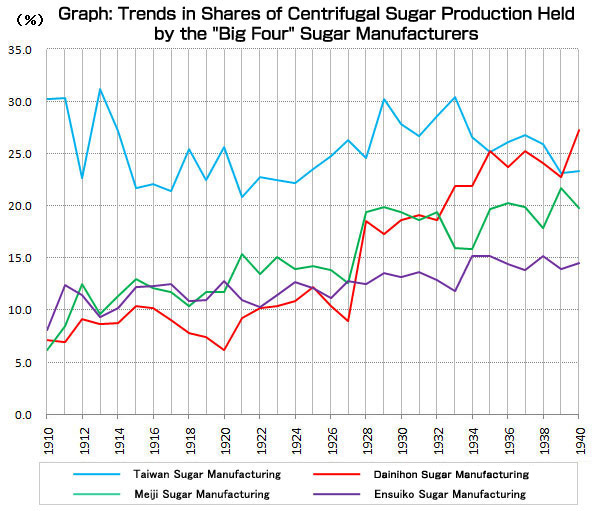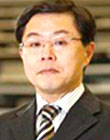Top>Research>Business History Research into the Modern Sugar Manufacturing Industry
 Index
Index
Business History Research into the Modern Sugar Manufacturing Industry
Fumikatsu Kubo
Professor, Faculty of Commerce, Chuo University
Areas of Specialization: Business History (Japanese Business History, Asian Business History), Economic History
Colonial Taiwan and the modern sugar manufacturing industry
Few people are aware that Japan actively sought to use Taiwan, a colony of Japan as a result of the Sino Japanese War, as a base for expanding the centrifugal sugar industry, which was one of the main industries in Japan prior to World War Two. At that time, Japan was still in an inferior position compared to western powers. In that respect, successful management of Empire of Japan’s first colony served as a test of whether it could thrive as an independent nation.
The phrase of modern sugar manufacturing industry as used in the title of this article refers to the centrifugal sugar industry (hereinafter referred to as sugar manufacturing industry), which was developed as a business in Taiwan prior to World War Two. The features of business history research in regards to this theme include examining uniqueness via case studies, conducting comparative analysis (specifically, international comparison and corporate comparison), and empirical analysis that focuses on the decision-making process of top management.
Characteristics of the modern sugar manufacturing industry
When discussing the modern sugar manufacturing industry, it is important to consider the close relationship with the cultivation of sugarcane, a raw material for sugar. This is because the amount of centrifugal sugar produced is significantly affected by the amount of sugar cane harvested. Indeed, expenses related to the raw material sugarcane accounted for 60% of production cost. At the same time, there was an issue of competition between the production of sugarcane and rice (the two major crops in Taiwan) in the region where raw material was harvested. This issue was a significant constraint which increased the cost of corporation management for sugar manufacturing companies. A factor to this was a system in which specified factories were required to make purchases for sugarcane cultivation only, but in which farmers were free to cultivate any crop they wished.
When taking a broad look at the history of the modern sugar manufacturing industry, it can be described as a search for cooperation based on competition. In this case, cooperation refers to the cooperative action taken against the backdrop of the Federation of Sugar Manufacturers, one of the largest cartels in pre-war Japan. Specifically, the main mission of the federation as a cartel was to suppress competition through agreements such as the Production Adjustment Agreements of 1933/1934 (in order to avoid overproduction, reduction of measures intended to encourage farmers to grow sugarcane), to manage interests within the industry, which had repeatedly dealt with a conflict of interests regarding side business of inland refined sugar and the plantation white sugar (centrifugal sugar as low cost as refined sugar) that would lead the industry in the 1930s, and to supplement business resources with the aim of sharing various information ranging from types of sugarcane to manufacturing methods for plantation white sugar.
In actuality, despite what is indicated by research on pre-war sugar manufacturing in Japan, the industry was in no way a simple oligopoly enabled by monopoly capital. However, even while searching for cooperation, there was also a foundation of constant and fierce corporation competition by a few key players. As discussed below, corporate management based on competition was the normal form of the business.
Key players in the modern sugar manufacturing industry and implementation of strategy
As the result of repeated alliances between 27 sugar manufacturing companies, the number of companies had been reduced to 11 in the early 1920s. After reorganization of the industry during the financial depression in 1927, only 9 sugar manufacturing companies would remain: Taiwan, Shinko, Meiji, Dainihon, Ensuiko, Niitaka, Teikoku, Showa, and Taito. Ultimately, due to further reorganization of the industry in conjunction with the intensification of the war regime in Japan, the modern sugar manufacturing industry was reduced to 4 key players known as the "Big Four": Taiwan, Meiji, Dainihon, and Ensuiko.

Source: Created based on the following reports from the Governor-General of Taiwan: Taiwan Sugar Industry Statistical Report No. 17, pp. 82-89; Taiwan Sugar Industry Statistical Report No. 20, pp. 84-86; Taiwan Sugar Industry Statistical Report No. 23, pp. 86-91; Taiwan Sugar Industry Statistical Report No. 26, pp. 84-89; Taiwan Sugar Industry Statistical Report No. 29, pp. 1, 84-89.
I will now discuss an overview of the strategy implemented by each of the Big Four sugar manufacturers. Taiwan Sugar Manufacturing focused on its core industry by taking full advantage of its resources (large company-owned farms and a raw material harvesting district in southern Taiwan, an advantageous region for sugarcane cultivation) as a pioneer in the industry. Taiwan Sugar Manufacturing actively conducted R&D in agriculture, such as developing sugarcane species and being the first company to use portable devices for measuring sugar content, which served as the cores for quality production increases. Additionally, Taiwan Sugar Manufacturing also started manufacturing plantation white sugar at roughly the same time as Ensuiko Sugar Manufacturing, a pioneering company in that field. As a result, Taiwan Sugar Manufacturing was able to maintain a sustained competitive advantage for a long period of time (see graph). Furthermore, as Chairman of the Federation of Sugar Manufacturers, Taiwan Sugar Manufacturing also served as the main coordinator for the management of interests.
Meiji Sugar Manufacturing implemented a multilayered and multifaceted strategy with companies such as Meiji Seika Co., Ltd. At the same time, the company utilized as its greatest resource the group power of “Dai-Meiji” which is supported by its own sales network operated by Meiji Shoten Co., Ltd. This strategy was designed to overcome the inherent uncertainty (sugar prices at the mercy of the international market and the effect of typhoons on sugarcane cultivation) of the sugar manufacturing industry. Moreover, during the financial depression, Meiji Sugar Manufacturing also purchased two factories with plantation refined sugar facilities. This enabled Meiji Sugar to start catching up with the top position held by Taiwan Sugar Manufacturing (see graph). During the mid-1930s, Meiji Sugar was able to overcome its vulnerability in agriculture which was brought on by the company motto of "simplicity and fortitude."
For Dainihon Sugar Manufacturing, which started from the inland refined sugar manufacturing industry, the bribery scandal involving Nihon Seito was a turning point for rebirth and renewed performance based on sugar manufacturing in Taiwan. The strategic transition to the modern sugar manufacturing industry was spurred by a merger with Toyo Sugar Manufacturing in 1927. Dainihon significantly improved its position by shifting its strategic focus from refined sugar to plantation white sugar. Through active M&A, the company was able to overcome the disadvantages in raw material harvesting districts and centrifugal sugar production capacity due to its late entry into the market. Dainihon started from calculated and realistic decision-making based on lessons learned from past mistakes.
Discussion of the strategy implemented by Ensuiko Sugar Manufacturing must begin from its pioneering activities in plantation white sugar. However, in order for this strategy to succeed, Ensuiko had to overcome two constraints: management mistakes caused by the overlap of several large-scale mergers and the bankruptcy of Suzuki Shoten, and the management of raw material harvesting districts which were scattered throughout Taiwan. Upon entering the 1930s, the demand for plantation white sugar rose greatly due to decreased prices and improved quality in conjunction with reduced consumption tax and quality production increases. As rival companies implemented strategies focusing on plantation white sugar, the advantage enjoyed by Ensuiko by the mid-1920s was not conspicuous.
Dynamism in the growth of the modern sugar manufacturing industry
After maintaining long-term competitive advantage for more than 30 years, Taiwan Sugar Manufacturing was surpassed by Dainihon Sugar Manufacturing due to the latter's active M&A strategy (see graph). This occurrence itself represents the dynamism of the modern sugar manufacturing industry. Since the three companies other than Taiwan Sugar Manufacturing faced constraints associated with management mistakes or late entry into the market, overcoming those constraints became urgent issues of those companies. As such, the essence of dynamism in the industry was the process of mutual cooperation within innovative corporate activities aimed at realizing rebirth, enhanced performance, and effect of newcomers.
The prime example of this dynamism was Dainihon Sugar Manufacturing, which triumphantly exceeded in overcoming the two constraints of management mistakes and late entry. Even more, the company succeeded in turning these constraints into business opportunity. It was this dynamism which enabled Dainihon to dramatically overcome Taiwan Sugar Manufacturing to capture the top position. Indeed, upon facing the most difficult constraints, Dainihon implemented the most radical and innovative corporate activities. Therefore, it can be said that corporate activities in response to the two constraints of management mistakes and late market entry were the driving force behind the growth of the modern sugar manufacturing industry. In marked contrast, although Taiwan Sugar Manufacturing faced the difficulty associated with initial constraints, the company did not encounter any other major constraints during subsequent business activities and engaged in stable management; however, its long-term competitive advantage eventually came to an end.
In other words, the true dynamism leading to the growth of the modern sugar manufacturing industry can be seen in the contrast between the two companies. This dynamism is seen in how there were several players that led differentiation, and how the position of those players shifted; there was also fierce corporate competition embodied by the series of swift response to imitation and improvement (for example, quality production increases and improvement in the quality of plantation white sugar). Dynamism was also present in the mutual cooperation of innovative corporate activities among the Big Four sugar manufacturers who served as key players. These two types of phased dynamism were the main driving force in the growth of the modern sugar manufacturing industry to become the main industry in pre-war Japan.
- Fumikatsu Kubo
Professor, Faculty of Commerce, Chuo University
Areas of Specialization: Business History (Japanese Business History, Asian Business History), Economic History - Professor Kubo was born in Shingu City, Wakayama Prefecture. He completed the doctoral course of the Graduate School of Commerce, Chuo University in 1994.
He is the author of Business History Research into the Modern Sugar Manufacturing Industry (Bunshindo Publishing Corporation, 2016), A History of Colonial Corporate Management: Empirical Research into Quasi-State-Owned Companies (Nihon Keizai Hyouronsha, 1997), and editor of Modern Sugar Manufacturing Industry Development and the Federation of Sugar Manufacturers—The Search for Competition-based Cooperation (Nihon Keizai Hyouronsha, 2009), Industrial Business History Series No. 9: Food Product Industry (Japan Business History Institute, 2016), and Competition among Corporations in Asia (Bunshindo Publishing Corporation, 2015) and more.
- Research Activities as a Member of Research Fellowship for Young Scientists (DC1), Japan Society for the Promotion of Science (JSPS) Shuma Tsurumi
- Important Factors for Innovation in Payment Services Nobuhiko Sugiura
- Beyond the Concepts of Fellow Citizens and Foreigners— To Achieve SDGs Goal 10 “Reduce Inequality Within and Among Countries” Rika Lee
- Diary of Struggles in Cambodia Fumie Fukuoka
- How Can We Measure Learning Ability?
—Analysis of a Competency Self-Assessment Questionnaire— Yu Saito / Yoko Neha - The Making of the Movie Kirakira Megane









